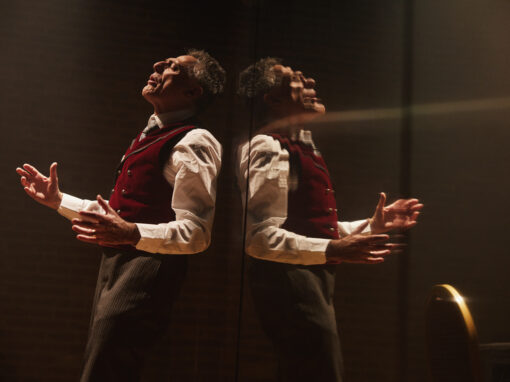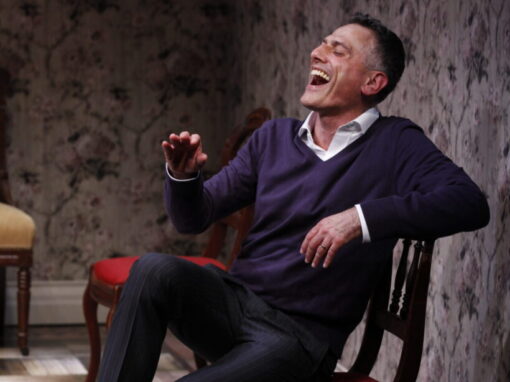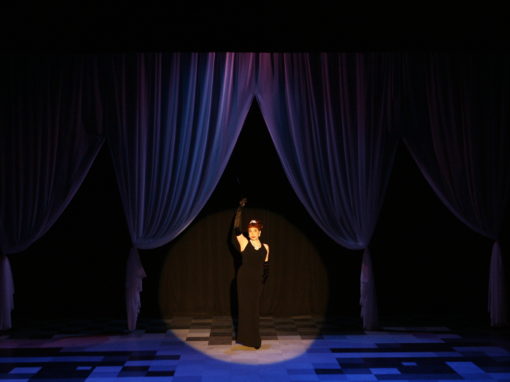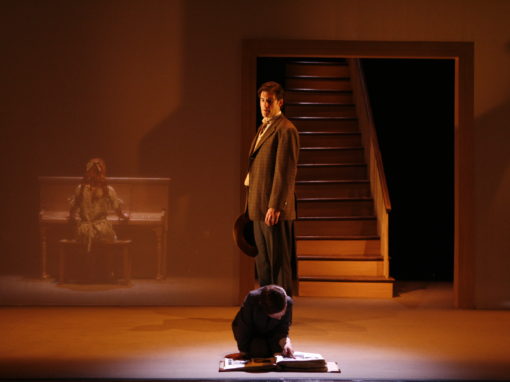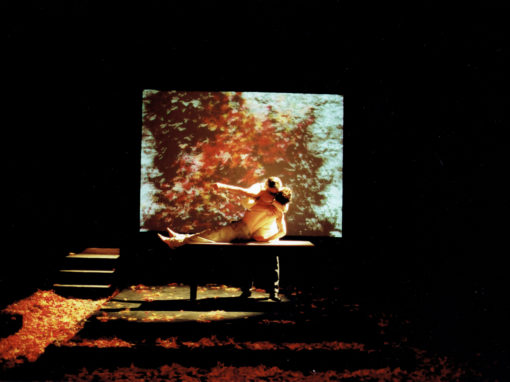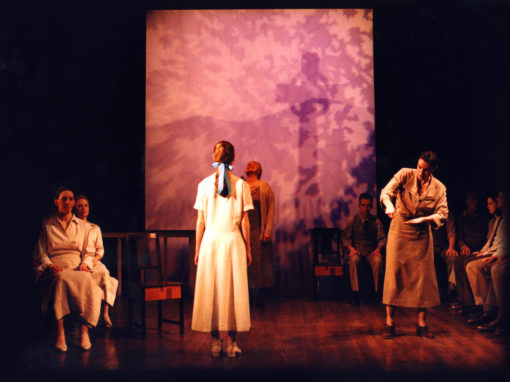Humble and Magnificent // By Stanley Bahorek
Actor Stanley Bahorek bathes in the replenishing artistic waters of collaborating in an ensemble.
Definition: Ensemble
1. a group of musicians, actors, or dancers who perform together.
2. a group of items viewed as a whole rather than individually.
Origin: French, ensemble – meaning “together”, “in a body”, “whole”
I have felt the glory of playing some titular characters: Amadeus in Amadeus, Candide in Candide. But, however exalting I found performing these roles to be, it is the two experiences of being in a richly talented, deeply collaborative ensemble with Transport Group that were transformative for me. These processes shaped who I am as an artist. The memories haunt and inspire me and inform how I work as a creative person today. These were not the kind of ensembles you typically think of in the theater, as I’m not an actor/singer/dancer triple threat, nor have I bounced from one Broadway chorus to the next. Instead, I’ve had the good fortune to be asked to act, sing, and collaborate in the creation of new works.
As we have all experienced isolation in the past year and a half, I’ve found myself longing for the kind of connection I felt in the ensemble of Transport Group’s productions of Queen of the Mist by Michael John LaChiusa (words and music) and See Rock City & Other Destinations by Adam Mathias (book and lyrics) and Brad Alexander (music). I want to recreate the sense of belonging that I felt then in my work as a producer in virtual spaces now.
What was the key to this particular type of ensemble work? Why has it left me pining for it, years later, nostalgic and mystified? I want to explore my memories of how it worked and how it felt … the moments of discord, the clashes of personalities, the utter confusion, and woeful self-doubt. “Ah, what bliss!” says the older version of myself.
Cut to a staging rehearsal in New 42 Studios for the fully realized production of See Rock City & Other Destinations. Jack has procrastinated blocking the final sequence, as any good director should. This finale comes out of a scene in which the terrified bride Kate, portrayed by Donna Lynne Champlin, has fled the rehearsal for her wedding and is now teetering on the edge of a scenic overlook facing down into Niagara Falls. The “What Ifs” of marriage have gotten the best of her and she is desperately in need of guidance. The Tour Guide (a mystic Jonathan Hammond) can only offer to her that,
The odds may be slim that they’ll make it through.
Even so, some people do…
Providence spares only a few.
Most don’t float.
Some people do.
“I have no idea what we are doing,” Jack says. These are magic words. This is the spell that a great collaborator casts. It requires a keen emotional intelligence to read the room and know that deep roots of trust have been established. And with the casting of this spell, all of the actors in the room perk up. So does the MD Justin Hatchimonji behind the piano. And Theresa Flanagan the stage manager. We all attune our senses to each other. It is time for collaboration in action. The music begins. We take turns singing our lines that hand off from one to the next like a slow-motion baton in a musical relay race going at the tortoises’ pace. We move through space. We look this way and then that way. We try to stay in character, but we are looking to each other for cues. It’s a version of the pool game Marco Polo but on dry land and no one has their eyes closed and we have no idea who we are looking for. We are timid and unsure-footed. And then…nothing works.
Jack doesn’t say much other than, “Okay … well, that wasn’t it.” So, we will try again. The music begins and we move through space. And then something serendipitous occurs; simultaneously, we each arrive at an opening between groups of seats, an aisle. In theatre class there is a game I teach where the students mill about the space until someone stops and then everyone must freeze. And when someone, anyone, moves again we must all begin to mill again. It teaches listening and proprioception. This moment in the rehearsal room for See Rock City felt like that game.
But then what? So, we pause and Jack casts his gaze to the floor. Maybe he is thinking, what can I offer here? “Try again from this measure of the music and go through to the end…?” And we do. The music picks up and we don’t move, we just look across at each other. Then someone moves so we all move, walking counterclockwise in a circle. One step, two steps, three steps…ten steps and then someone freezes so we all freeze. We’ve arrived at a new musical section and at a new physical orientation in the space. Another theater game I teach is where the students need to close their eyes and count to twenty as a group without anyone speaking the next number at the same time as another person. This moment in our rehearsal felt like that. 1, 2, 3, 4, 5, 6, 7, 8, 9, 10. We did it.
We were all interpreting the score simultaneously. And it felt weird and slow and silly. But despite inefficiency—or perhaps because of it—something was made by the collective. We sang our cacophonous “I do”, trusted each other as an ensemble, thought together and moved together, and we staged a number together. We found an embodiment of what that text and music means. The choral “I do” ringing in the air was our affirmation of the power of working together as one.
Flashback: Riding on the subway underground through midtown Manhattan, I see Mary Testa sitting across from me. Is that the comedic big-voiced Athena, Goddess of Broadway Belting, Mary Testa? I think. I wanna have her courage when I’m on Broadway one day. Can I approach her? And I do! I tell her how much I admired her absolutely brilliant and bonkers duo-de-force with Jackie Hoffman in Xanadu. She is warm and genial, if surprised. I glow for the rest of the day.
Cut to a few years later, and the greatest process of my life: being in the ensemble of Queen of the Mist by Michael John LaChiusa. This was a holy meeting of talent and text, of story and storytellers. Michael John, in a great tradition, carved a masterpiece that was inside the invisible marble of music. Working like a master herself, Mary Testa brought to life the great spirit of the lesser known, historic daredevil goddess Anna Edson Taylor, the first person to go over Niagara Falls in a barrel and survive. (Yes, both shows coincidentally take place at Niagara Falls.) Five of us—Tally Sessions, D.C. Anderson, Theresa McCarthy, Julia Murney, and I scaffold this great resurrection as an ensemble of figures from her life, real and imagined.
As Theresa so expertly retold in her recent Transport Group essay, through metaphor we acted as myriad people in Anna’s life. I remember a notes session in which Theresa exclaimed this idea, “We are acting through metaphor!” I was befuddled by this statement at the time. But I aspired to learn from her and have come to embrace this concept as central to my understanding of acting technique. Metaphor is a powerful tool for understanding the human experience. It takes something known and compares it to something less known. Metaphor builds a bridge to new ideas.
To play a variety of characters, to change costumes and voices and show off the range of our acting abilities was a thrill. I was motivated by my fellow ensemble members. The enormous distance between Theresa’s characterization of Anna’s deeply conservative, upstanding, and concerned sister and of the foul-mouthed floozy who steals Anna’s barrel and performs in the vaudeville circuit was awesome. One was restrained and the other wild. I wanted my characterizations to be as bold as hers. I imagine we were all influencing each other to go broader, deeper, weirder, more nasal, more vulnerable. We were like Olympians spurred on by competitors, but with a goal being vividness, not medals. It was an incredibly generous room. We wanted the world of the play to come alive in the boldness of our characters. Michael John’s writing asked this of us. And in that world Mary Testa’s Anna could exist and move mountains.
In the 11 o’clock scene, my character, Mike Taylor (no relation to Anna Edson Taylor), enters from underneath the audience risers and sees his hero, Anna Edson Taylor, sitting outside selling souvenir postcards. I quickly changed into the authentic, woolen, historically precise fatigues (by the authentically brilliant Kathryn Rohe). With haze and a long blinding light shining on me, I was certain I was appearing in the greatest theatrical illusion ever to be staged (thank you, R. Lee Kennedy): A ghost of a WWI soldier appearing in the mist, dead but not yet dead. I walked down the alley as Mike and approached Ms. Taylor, calling to mind how I, as Stanley, had approached Mary on the subway. “Are you Anna Edson Taylor?” Mike is enlisted and is leaving soon for the European theater of war. Like my conversation with Mary, Mike’s conversation with Anna is prescient; soon Stanley and Mary will be together, soon Anna and Mike will be together. I wanted to portray Mike, a character who appears in one scene and with only a few lines, to be as vivid as Tally’s police officer, Julia’s Carey Nation, D.C.’s Manager, and Theresa’s sister Jane. They were my collaborators in how they encouraged excellence from me.
For Anna, this scene with Mike Taylor is a brief encounter with a devoted fan before the inevitable end. “I’m ready now,” she says after gifting a souvenir to her fanboy—a postcard of her tintype imprinted with the courage he needs to go off to war. She dies and is rewarded in Heaven with gold everything, but not before she rewards the audience with the tale we’ve all been begging and berating her for: What was it like going over the Fall? She sings:
Sky, slate grey blue.
Clouds.
Migrating geese.
Fog
Chill in the air.
Breathe now, Anna
Sun.
Glazed in mist.
Sound:
Hovering bees.
Clean.
Bright everywhere.
Taste it, Anna.
Beautiful world.
Terrible world.
Goodbye.
Into my barrel/cradle/coffin.
Goodbye.
Beautiful world.
Terrible world, farewell.
Into the water/gravesite/heaven or hell.
Why?
People will ask.
There is no beautiful, terrible ‘why’;
No answer at all.
No answer to give.
Except to live and fall…
And here again, as I had experienced in rehearsal for See Rock City, the ensemble is called forth to think and move as one to embody her fall, her transition to the other side. Scott Rink, the choreographer assigned the impossible task of working with six actors who cannot and do not dance (don’t ask them), has the vision to create a reenactment of a historic photograph of Anna emerging from her barrel post-fall. We gather around the photograph and examine it together. Then we form a tableau. The music begins. Mary approaches us. We extend our arms to her. We lift her in time with the ascending chords. We flow like the waters. We support Anna out of her barrel, up, and through…and our legs cramp. We’ve been holding a plié and stretching our arms for quite a while. We are confused. I’m unsure where my gaze should be. I have the only spoken line, “My God! The woman is alive!” and I have no clue how to deliver it. Should it be mezzo forte? Ethereal? Commanding? Full of awe? Jack’s answer, “Yes, it should be all of those things.” So, we will try again.
Theresa McCarthy seems to be a ballerina trained in Russia, rolling up her sleeves and lunging sideways. Tally was going to the gym a lot and his physique was impressive (still is). He flexes and supports someone’s back. D.C. is so game to play along, comfortable going with the flow. Julia is a gazelle, poised and focused. Her gaze is laser-like and I think, did she learn that from her time as Elphaba? I feel young and racked with self-doubt. But I stay in the game. We try again and Scott nudges an arm, lifts a hand, rotates my head. And Mary as Anna moves through us at a pace that times out just perfectly so that she has arrived at the other end of the stage at the arrival of a new section of the song. We’ve found it.
This was some of my greatest work; my contribution was humble and magnificent. For a few weeks in the late fall of 2011, we reenacted this reenactment eight times a week. Moving at a glacial pace, we danced together in perfect synchronization to the rolling chords Michael Starobin’s orchestration warmed and tilted, Chris Fenwick’s conducting swelled and pushed, as everyone in the Judson Church basement was fixated on this organism, our ensemble.
I miss the feeling of artistic connection I felt working with Transport Group. It gave me a sense of belonging, satisfying one of the deepest human needs I haven’t felt in a while. Add this to the list of pains we have all suffered during this pandemic. I am discouraged when people say, “Nothing can replace being in person in a theater.” I bristle because this sentiment limits our ability to see the possibilities these constraints provide us if we innovate. And because I know they are right. Still, I’m desperately, wildly, and excitedly committed to finding new ways of connecting through stories and having a shared experience. But I think I know that it will take some searching, longing, and patience on my part until I create something in an ensemble the way we did with Transport Group. And maybe I never will.
I wouldn’t know how to write a textbook explaining how this magical ensemble work can be achieved. But as I’ve waxed nostalgic here, I see that it requires a group of people dedicated to theater, music, and acting, all deeply connected to a text, a story, and a specific embodiment of that story. It requires training, resilience in the face of discomfort, generosity of spirit, and trust. Trust is key. And trust requires time. You also must be willing to cast the magic spell and say, “I have no idea what we are doing.” (Try it in your next meeting. It works wonders.) The alchemy is complex, to be sure. And it is simple. But simple doesn’t mean it is easy. When the chemistry is right, something captivating is created. I think about that busker in the park who uses enormous loops of rope to make unbelievably large bubbles with just the right mixture of dish soap, water, sugar, and a practiced flick of the wrist. The huge bubbles glisten and float for a brief moment as we gaze like children, grinning from ear to ear, until there’s a silent pop and the oily-rainbow glistening beauty has vanished. Collaboration in a small company of auteurs is finicky and strange, mystic and unclear. And it is powerful. It pulls the onlookers in, surrounded by voices singing “I do” to a bride standing on the edge of Niagara Falls as she finds the foolish optimism to walk down the aisle. And collaboration draws us into the barrel as it plunges over Niagara Falls with Mary Testa holding us in the power of her commitment as we, an ensemble, fall together towards Heaven. Ah, what bliss.

About the author:
Stanley Bahorek is the executive director of Mind’s Eye Producing (www.mindseyeproducing.com), a creative consulting company that envisions bespoke in-person, virtual, and hybrid experiences that foster human connection through great storytelling. He co-produced the world premiere, NYC productions of Charles Mee’s soot and spit, and the new play Sheila by The Associates. As an actor, Broadway credits include the 2020 revival of Company, The 25th Annual Putnam County Spelling Bee, West Side Story (Carnegie Hall), and Amazing Grace. Off-Broadway credits include February House (The Public Theater), Queen of the Mist (Transport Group), See Rock City & Other Destinations (Transport Group), Inventing Avi (Abingdon Theatre), The Explorers Club (Manhattan Theatre Club), and Little Me (Encores!). Dedicated to new works, he is an original cast member of more than twenty world premiere plays and musicals. Original cast albums: Amazing Grace, February House, Queen of the Mist, See Rock City & Other Destinations, and Honk!. He has performed in over two dozen regional theater productions; favorites include the title roles in Amadeus (The Alley), Candide (5th Avenue), Nerds (Philadelphia Theatre Company), Ken Ludwig’s new play Baskerville at Arena Stage and McCarter Theatre, Caroline, or Change at Tantrum Theater and Assassins at Yale Repertory Theatre. He plays ‘Barry’ in the Emmy Award-winning Netflix show Master of None. He holds a BFA in Musical Theatre from The University of Michigan, a Master of Arts from Baruch College, and teaches at The American Musical and Dramatic Academy and Princeton University. www.stanleybahorek.com

Explore Our Past Shows
